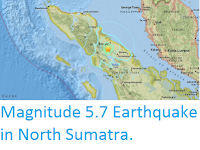The body of a German tourist missing since Wednesday 21 June 2017 has been found close to a waterfall on Mount Sibayak, North Sumatra, on Thursday 29 June. Klaus Wolter, a resident of Singapore, had set off to climb the volcano, a popular tourist attraction, but failed to return, prompting an eight day search by Indonesian search and rescue teams. His body has been identified by his wife.
Mount Sibayak is a 2200 m stratovolcano (cone shaped volcano made up of layers of ash and lava) located close to the town of Berastagi in North Sumatra. It has not erupted since 1881, but is still considered an active volcano due to its numerous steam vents and hot springs. The volcano is considered an easy climb, with a picturesque, if somewhat acidic, crater lake.
The Indo-Australian Plate, which underlies the Indian Ocean to the west of Sumatra, is being subducted beneath the Sunda Plate, a breakaway part of the Eurasian Plate which underlies Sumatra and neighbouring Java, along the Sunda Trench, passing under Sumatra, where friction between the two plates can cause Earthquakes. As the Indo-Australian Plate sinks further into the Earth it is partially melted and some of the melted material rises through the overlying Sunda Plate as magma, fuelling the volcanoes of Sumatra.
The Subduction zone beneath Sumatra. NASA/Earth Observatory.
This does not happen at a 90° angle, as occurs in the subduction zones along the western margins of North and South America, but at a steeply oblique angle. This means that as well as the subduction of the Indo-Australian plate beneath the Sunda, the two plates are also moving past one-another. This causes rifting within the plates, as parts of each plate become stuck to the other, and are dragged along in the opposing plate's direction. The most obvious example of this is the Sumatran Fault, which runs the length of Sumatra, with the two halves of the island moving independently of one-another. This fault is the cause of most of the quakes on the island, and most of the island's volcanoes lie on it.
The movement of the tectonic plates around Sumatra. NASA/Earth Observatory.
See also...
Follow Sciency Thoughts on Facebook.









